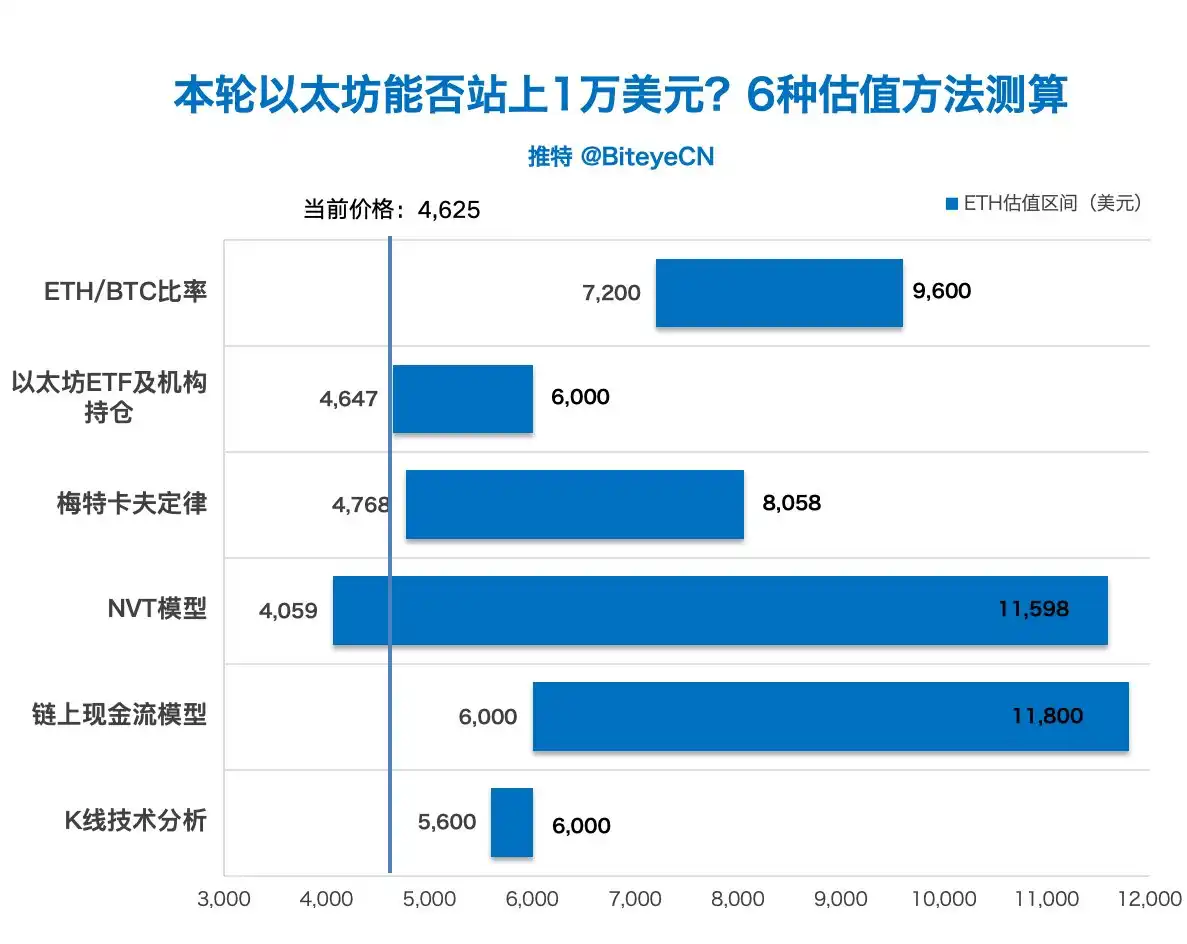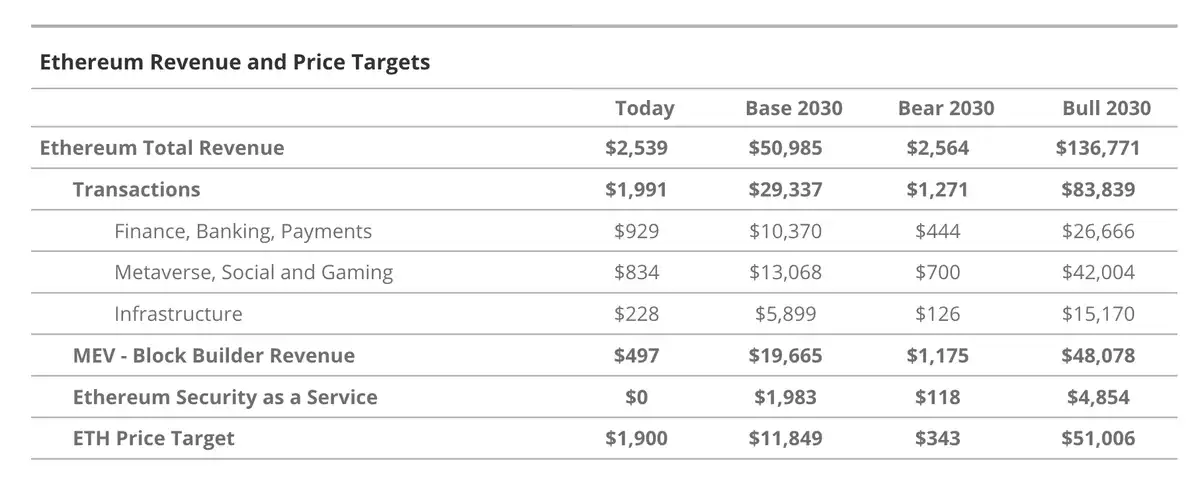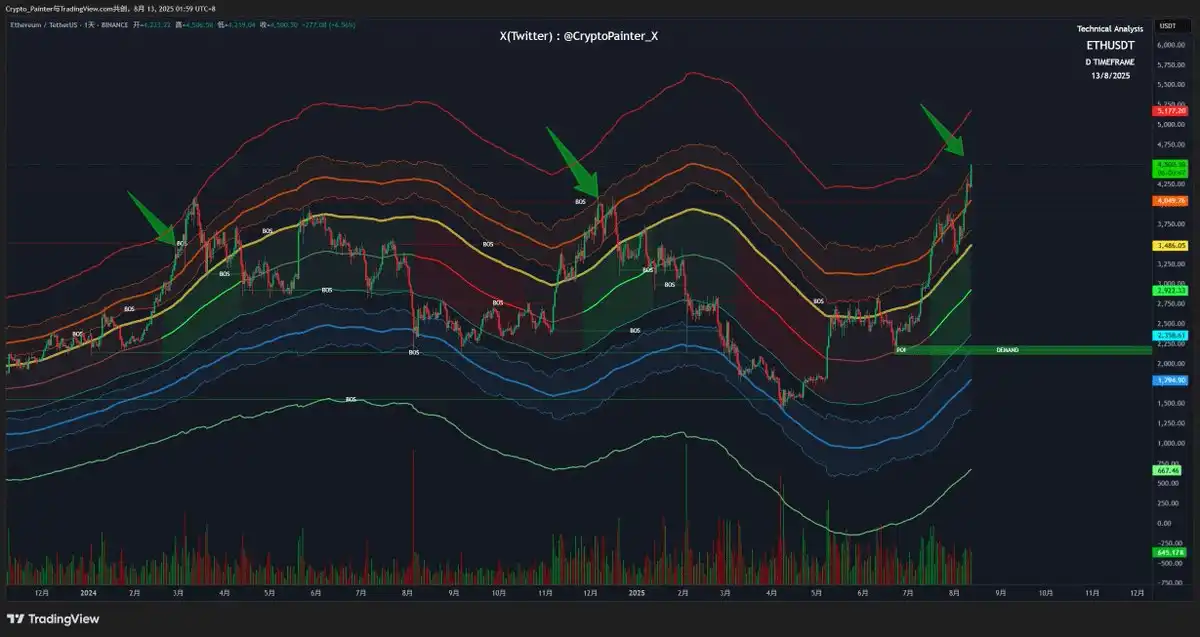6 Valuation Methods: Can This Round of Ethereum Reach $10,000?
2025-08-14 09:00
Original Title: "Can This Round of Ethereum Reach $10,000? 6 Valuation Methods Analyzed"
Original Source: Biteye
ETH has rebounded from the April low and is currently above the $4,500 level.
If 2024 was the beginning of a bull market ignited by Bitcoin ETFs, then 2025 may be Ethereum's turn to shine.
This article analyzes six valuation methods to determine whether ETH can challenge the $10,000 mark!

1/8 ETH/BTC Ratio
First, we compare the relative valuation of ETH and BTC.
The ETH/BTC ratio has been very stable over the long term, but the current ratio is only 0.0372, which is in the lower to middle range of the past five years, indicating that ETH may be undervalued at present.
Based on the five-year average of 0.0518 for the ETH/BTC ratio, assuming BTC remains around $120,000, the corresponding ETH price would be $6,214.
If we refer to the ETH/BTC ratio during the previous bull run of 0.06-0.08, and still assume BTC remains around $120,000, the corresponding ETH price would be $7,200-$9,600.

2/8 Ethereum ETF and Institutional Holdings
With the significant rise in ETH price, off-chain funds have poured into Ethereum ETFs. Many people overlook the actual impact of Ethereum ETFs and institutional purchases, which are not just emotional boosts but also substantial buying pressure.
According to data from @SoSoValueCrypto, Ethereum spot ETFs have set a new historical high, with a net inflow of $1.019 billion on August 11th in Eastern Time. The current total net asset value of Ethereum spot ETFs is $25.712 billion, with holdings of approximately 6 million ETH, accounting for 4.96% of the current circulating supply of ETH,
Compared to the 6.48% for BTC, there is still room for growth. In addition, 70 Ethereum reserve foundations hold approximately 3.49 million ETH, accounting for 2.89% of the ETH circulating supply. BMNR has publicly stated its goal to eventually hold 5% of the global Ethereum circulating supply. After deducting the staked and locked 36.17 million ETH, the free-floating supply is about 75.1 million ETH.
The next price projection is based on a simple assumption: the reduction in the free-floating supply will proportionally increase the price per ETH.
That is, the new price = current price × (target free-floating supply / current free-floating supply)
If we consider ETFs and institutional reserves as a whole, they currently hold 7.85% of the total supply. Assuming this percentage increases to 10%, and the staking lockup ratio remains relatively unchanged, the free-floating supply will shrink to approximately 72.52 million ETH, resulting in an estimated price of about $4,647; if it increases to 15%, it would reach approximately $5,070; if it increases to 20%, it would approach $6,000.
This does not take into account the demand-side amplification effect, so the actual price increase could be higher. Additionally, the incremental capital from ETFs and institutions usually takes some time to complete delivery, meaning that the ETH price center will be lifted long-term and steadily, rather than experiencing a short-term surge.
3/8 Metcalfe's Law
Many people discuss ETH valuation by focusing on price fluctuations and hot narratives, but ignore the long-term support of on-chain activity for network value. Metcalfe's Law states that the value of a network is proportional to the square of the number of active users. Applied to Ethereum, this means network value ≈ k × (daily active addresses)².
In simple terms, "the more users, the more valuable the network." A quadratic growth in user count leads to exponential growth in market cap.
According to BitInfoCharts data, on August 13, 2025, the daily active addresses (DAA) on the Ethereum mainnet were approximately 971,486, the current ETH price is about $4,500, the total circulating supply is about 120.7 million, and the market cap is about $543.1 billion. Substituting into the formula gives the current coefficient k ≈ 0.576 (USD/address²).
With this k, we can calculate prices under different levels of activity:
If DAA increases to 1 million, the price would be approximately $4,768 (+6%)
If DAA increases to 1.1 million, the price would be approximately $5,769 (+28.2%)
If optimistically reaching 1.3 million (close to 90% of the historical high), the price would be approximately $8,058 (+79.1%)
This calculation assumes that the staked amount and the circulating supply remain relatively stable, and an increase in activity directly amplifies the network value, thereby increasing the price of each ETH. Unlike ETFs and institutional purchases, the Metcalfe method reflects the endogenous growth of on-chain usage and economic activity, it does not depend on external capital inflows, but rather on the compounding of network effects.
Note that once activity and capital conditions resonate—on-chain transactions increase, fees rise, and burning volume recovers—coupled with the effect of ETFs and institutional capital contraction, ETH prices will be driven by both supply contraction and network expansion, potentially rising much faster than predictions based on a single factor.
4/8 NVT Model
NVT is essentially a "cryptocurrency version of PE". Given a reasonable NVT multiple (based on historical ranges) and future daily transaction volume, we can reverse engineer the market cap and price.
NVT = Market Cap (USD) / Daily On-Chain Transaction Volume (USD), calculated as NVT=518B/14B=37
The historical NVT of ETH has generally ranged between 60–110, and currently it is in the lower part of the historical range. Assuming the NVT multiple remains within the reasonable range of 60/80/90/100/110 for 6–12 months, and the daily on-chain transaction volume (USD) considering volatility is expected to be between 7B–14B/day.
6-Month Scenario
· Conservative: NVT 70, daily transaction $7B → Market Cap ≈ $490B → Price ≈ $4,059
· Benchmark: NVT 80, daily transaction $9B → Market Cap ≈ $720B → Price ≈ $5,965
· Optimistic: NVT 90, daily transaction $12B → Market Cap ≈ $1,080B → Price ≈ $8,947
12-Month Scenario
· Conservative: NVT 75, daily transaction $8B → Market Cap ≈ $600T → Price ≈ $4,971
· Benchmark: NVT 90, daily transaction $10B → Market Cap ≈ $900T → Price ≈ $7,456
· Optimistic: NVT 100, daily transaction $14B → Market Cap ≈ $1,400T → Price ≈ $11,598
This means that the network effect of ETH is currently supporting a valuation base of $5,000-$12,000.
5/8 On-Chain Cash Flow Model
Treating the "revenue" generated by the Ethereum protocol (fees, MEV, etc.) as cash flow, we measure the network value. As the Ethereum application ecosystem expands, the network's "revenue" growth can enhance the ETH valuation.
Asset management company VanEck predicts, based on this approach, that with the introduction of ETFs and other benefits related to Ethereum staking in 2025, the ETH price could approach $6,000. In a report from 2023, VanEck had already made valuations for ETH prices, assuming continued growth in on-chain fees and usage, the model suggests that ETH could rise to about $11,800 by 2030. See the chart below:

6/8 Technical Analysis of K-Line
@CryptoPainter_X believes that although ETH is currently facing some historical selling pressure from the supply area of the 2021 high, on a 4-hour technical structure, the highs and lows are slowly rising without any clear destruction.
Observing the ASR channel, ETH price is oscillating and rising above the orange average pressure band, which is a strong formation, indicating that market demand is gradually digesting the supply near historical highs.
The daily ASR channel shows signs of breaking through the average pressure band. The last similar breakout occurred at the beginning of 2024, and if this breakout is successful, the daily target may directly touch the daily overbought line (approximately $5,600).
Another possibility is repeating the movement seen at the end of 2024, encountering extreme pressure along the upper edge of the orange channel.
Overall, the current situation remains positive, and there is a possibility that ETH price may reach $6,000 in the medium term.

7/8 Scenario Forecast by Crypto Analysts
Some crypto analysts and media L provide a series of scenario-based forecasts for ETH prices:
1. Crypto analyst @VirtualBacon0x believes that ETH has entered a new macro bull market. Under the baseline scenario, ETH is expected to reach the $6,000-$7,000 range by the end of 2025, with a long-term target of about $10,000 by mid-2026. If extremely optimistic, with a full-blown market frenzy, BTC reaching $200,000 and ETH outperforming, Virtual Bacon estimates that ETH could reach as high as $16,000.
2. Wall Street analyst Tom Lee said in July on the Bankless podcast that in the short term, ETH should at least rebound to $4,000; and by the end of 2025, it is reasonable for ETH to reach $7,000, even $12,000 or $15,000.
3. Former CEO of BitMEX Arthur Hayes gave a target price of approximately $10,000 for ETH by the end of 2025, which belongs to an optimistic bull market scenario. In his article in July 2025, he emphasized that the U.S. policy shift towards credit expansion will bring a large amount of liquidity, and combined with Western institutions rekindling interest in Ethereum, these macro factors will become key catalysts driving ETH upward.
4. Cryptocurrency media Bankless proposed in their 2025 outlook that ETH could potentially reach $15,000 in an extremely bullish scenario. In their annual forecast, they stated that new drivers such as the AI boom could trigger another round of cryptocurrency frenzy. In this optimistic scenario, Ethereum's price could climb to the ten-thousand-dollar level. The underlying assumptions include ample market liquidity, narrative trends (such as AI + Crypto), and the continued consolidation of Ethereum's dominance in the DeFi sector.
8/8 Editor's Summary
Considering seven valuation methods, ETH has a high probability of reaching the $6,000-$8,000 range in 2025. If market sentiment is high and on-chain activity continues to grow, breaking through $10,000 is not impossible, and in an extremely optimistic scenario, it may reach the $12,000-$15,000 range.
This is not just "market speculation," but a joint performance of on-chain data, capital behavior, and macro liquidity. Whether or not ETH actually reaches $10,000, ETH as the infrastructure of the crypto ecosystem has already firmly established itself in multiple value pricing systems.
Risk Warning: The content of this article is for informational purposes only and does not constitute any investment advice. The price of ETH is influenced by multiple factors such as market sentiment, on-chain activity, and policy changes, with high volatility. Please make decisions based on your own risk tolerance and bear the investment risks yourself.
Disclaimer: Contains third-party opinions, does not constitute financial advice








Alpha Research
Alpha New Token Research Report, Binance Alpha Operation Suggestions
Popular Airdrop Tutorial
Selected potential airdrop opportunities to gain big with small investments
Crypto-linked Stocks
Crypto-stock linkage, real-time market quotes and in-depth analysis
Market Analysis
BTC/ETH, Major Cryptocurrencies, and Hot Altcoins Price Trends
Regulatory Watch
American Crypto Act – timely interpretations of policies worldwide
Frontier Insights
Spotlight on Frontier, trending projects, and breaking events
Crypto Weekly
Tracking on-chain movements of the smart money and institutions

ChainThink App

WeChat Official Account

WeChat Customer Service







